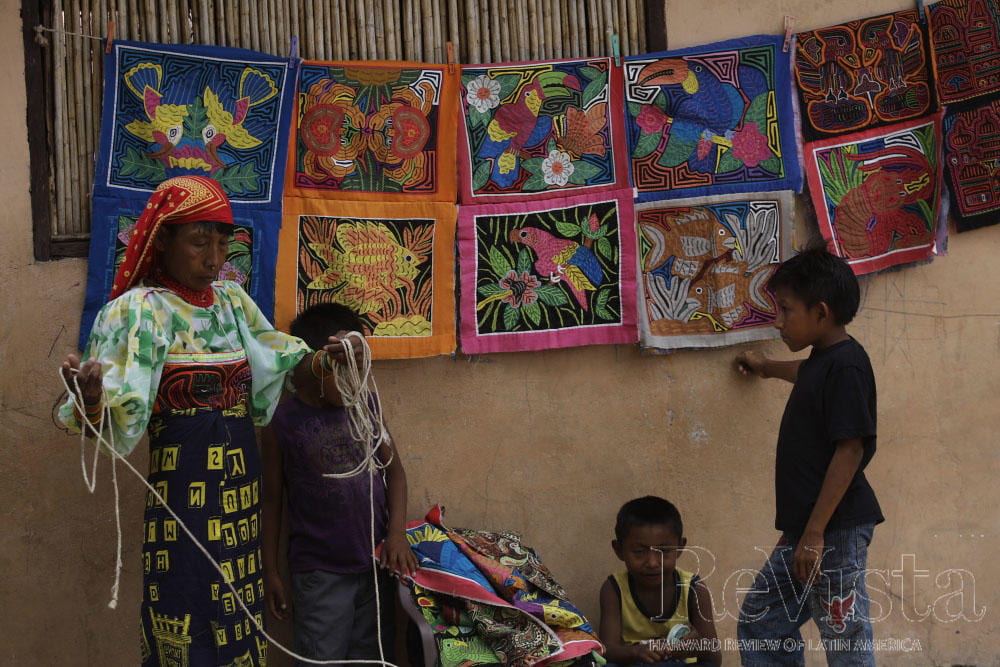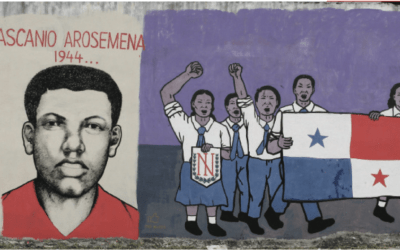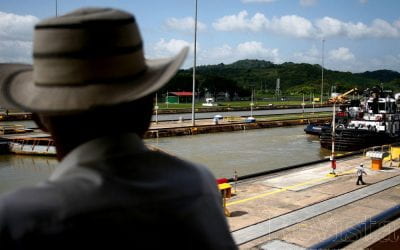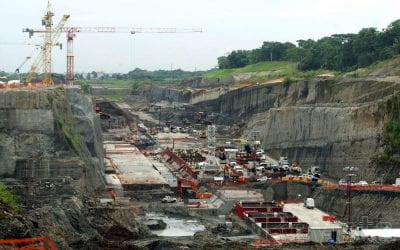The Panamanian Novel
History as Magnificent Fiction

A Guna Indian shows how molas with their fanciful themes are made. The Panamanian novel is influenced by the country’s special geography and history. Photo courtesy of La Prensa/Bienvenido Velasco.
Pueblos perdidos, the novel which earned Gil B. Tejeira Panamá’s Miró Literary Prize for 1963, tells the story of Gatún Lake, at the time the largest artificial reservoir in the world, through which ships sail from the sets of locks at one end of the Panama Canal to the locks on the other side, for 23 miles. The vast, watery landscape swallowed whole mountains that then became islands; towns and villages which had sprung into being at the edge of the transoceanic railway were plunged into its depths. Divers tell, in hushed whispers, that the church bells still toll, grieving for those who died whilst building the greatest marvel of the modern world.
The Panamanian novel, as a whole, is rooted in history, with the Panama Canal often as its cornerstone. At the same time, it belongs “to the great, unexpected and mythical world of Hispanic literature.” The novel—in Panamá and beyond—has proved its staying power as a literary genre at a time when its disappearance was all but a foregone conclusion. Ranging from historical novels to psychological thrillers, the Panamanian novel is at once very Latin American and influenced by its special geography and history.
When other novelists created works that went beyond local affairs and matters of their lands, in our case, the subject matters of the Panamanian Fatherland and the Canal, above all others, continued to be a perennial treasure trove and marked our literary output insofar as it was a core issue of our economy and our centennial struggle for national sovereignty.
The issue of the canal as a central motivator turned into a proud asset for a country that is today considered to have a privileged economy. The canal is a total presence and functions seamlessly, as the colossal prodigy it still is.
By now, the Panamanian novel has ceased to sail only through the Canal. It is different, more cosmopolitan, psychological, with new subjects and intent. But before getting to today’s novels, let’s take a brief look at the history of the genre in Panamá.
During the Colonial and early Republican eras, Latin American fiction was forced to take a back seat, given the torrential hyperbole of reality. Clearly influenced by the 18th Enlightenment century, Panamá’s first literary expressions were patriotic hymns and odes to the Fatherland. Even later, during the age of Romanticism, there was no room for romantic themes; the wounds inflicted by the struggles for independence had yet to heal, and resentment ran deep against the cruel treatment of the native peoples and the ignominious slavery of black people; with few exceptions, these were the sources of our literature.
In March 1821, the first printing press arrived in Panamá. Although many believe that the first truly isthmian literary generation was born during that century, Rodrigo Miró, father of Panamanian literature’s historiography, cites the discovery of some 18th century manuscripts penned by Panamanians as early as 1638. Yet, despite some novelistic attempts, the essay and poetic form dominated until the 19th century.
The 1870 novel María by Colombian Jorge Isaac was widely read in Panamá. As well, the construction of the canal by the French in the late 19th century promised not only material wealth, but cultural prosperity: more readers became available for a literary production by better educated writers, often influenced by the movement started by Rubén Darío, the universal Nicaraguan.
However, the all too brief influence of French language and culture was as doomed as De Lesseps’ dream of a transoceanic pathway. In 1888, Mélida, by Panamanian Jeremías Jaen, was published in New York. In 1889, the construction of the French canal ground to a halt. In 1903, just as hopes for the canal were being revived, Panamanian writer Julio Ardila published the novel Josefina in installments. Miró points out that “the reader is made aware of the lack of true and intimate coexistence between the local population and foreigners. The presence of strangers is purely a matter of existing within the same confines.” This work, as Miró indicates, is “the starting point of the Panamanian novel.”
In 1913, Ricardo Miró publishes, also in feuilleton format, Las noches de Babel, and later the novel Flor de María, but literary production continued to be relatively scarce. In 1940, Panamá welcomes the important historical novel by Octavio Méndez P., El tesoro del Dabaibe, in which Vasco Núñez de Balboa is turned into legend; Another important work from this period is Crisol, in which José Isaac Fábrega defines the country as a racial melting pot, and a new hope after the financial disappointment resulting from the utopian canal.
Authors turned to their roots for answers, and the new literature was inspired by the country and its people, as penned by such writers as José María Sánchez Borbón and Mario Augusto Rodríguez, Ramón H. Jurado, Carlos Francisco Changmarín, Julio B. Sosa and Gil Blas Tejeira.
The Panama Canal became a cornerstone of Panamanian literature, with Luna verde by Joaquín Beleño, a Canal Zone journeyman and mason who suffered the injustices depicted in his novel. It was the trailblazer for the stark issues of the day.
In the early 1940s, the novel acquired a prominent place in the Panamanian literary scene, in no small part because the country’s foremost literary award—the Ricardo Miró Prize—was established in 1942. That period produced El cabecilla, by José Agustín Cajar Escala, awarded the first Miró. The novel deals with the conflicts arising in the countryside; it describes everyday problems caused by the social inequalities between peasants and landowners. Other important works include San Cristóbal (which earned an award from the Ministry of Education in 1943) and Desertores by Ramón H. Jurado, winner of the second Miró Prize, which fictionalizes the everyday life in the country’s sugar mills.
Rogelio Sinán’s Plenilunio is a psychological thriller which, besides winning the Miró of 1943, gained further acclaim overseas with the award for the best foreign book from Chile’s Pen Club in 1947. The Master, a title justly deserved by Sinán, penned many works in diverse genres, including prize-winning short stories. In one of these collections, Sinán traces something akin to the history of Panamá through the development of Taboga, which rises out of the sea, right in front of our metropolis.
In 1951, Puente del mundo won the Miró. Its author, Renato Ozores, also wrote Playa Honda, a novel perfectly capturing the reality of the nation’s capital.
A short time later, in 1957, Guillermo Sánchez Borbón wins the Miró under the pseudonym Tristán Solarte, with El ahogado, a novel in the best style of psychological thrillers, which places him on the forefront of Panamanian writers. In the context of a portrait of life in the banana plantations, Solarte recreates the legend of the excruciating divine punishment suffered by a woman whose infant child dies whilst she commits adultery, known as “La Tulivieja” or the “woman in mourning.”
Dimas L. Pitty’s Estación de navegantes—Miró Prize, 1974—draws a fair picture of the U.S. presence in the country since the creation of the Canal Zone, with vivid imagery of the uncouth dregs of humanity on which the plot is based. Intricately structured, and divided into parts by a chronicle well suited to the noise and crowds, days and nights of Panama City, the work uses contemporary techniques and language.
This approach continues with Ernesto Endara’s Tic tac, which took the first Miró Prize of 1992; the author has won Miró Prizes for several other genres another eleven times. He also wrote Pantalones cortos, 1997,and Pantalones largos, 1998; two novels about a young man’s experiences in his beloved hometown, Panama City. The subject matter’s apparent simplicity does not detract from the author’s mature critique of “a society that subsists on the fragility of the family and the misfortunes of the mother/father,” an ever increasing occurrence in our society.
Rafael Pernett y Morales, in his populist and emblematic Loma ardiente y vestida de sol, creates a raw narrative about Panama City that is relevant to any poverty-ridden place in Latin America. Justo Arroyo, another recipient of multiple Miró Prizes, is well-known for his novels Dedos, Dejando atrás el hombre de celofán, Capricornio en gris, Semana sin viernes and Réquiem para un duende.
Our literature lacks its fair share of novels by female authors, save for some exceptions. To wit, Luisa Aguilera Patiño, El secreto de Antatura, Miró Prize 1953; Acracia Sarasqueta de Smith, Miró Prize 1962 for El guerrero, also author of Una dama de primera, which Rodrigo Miró once recommended to me: “you should read it, it is very interesting, the characters are very well fleshed out, and she describes and narrates each situation quite tastefully.” Yolanda Camarano de Sucre is another woman novelist with La Doña del Paz, Miró Prize 1966, and Los Capelli, which garnered the award the following year. Both works set forth, in a picturesque and realistic manner, how foreigners see Panamá and Panamanians.
Isis Tejeira deserves a special mention for her novel Sin fecha fija, which excels in its use of narrative to denounce the unjust treatment and repression of women; underneath the plot and ever present is the yearning for the Panamá of old, with scenarios and circumstances which remind us of provincial morality and customs.
Rosa María Britton is one of Panamá’s most prolific and widely read female authors. Hers is the persona of the born storyteller. Her boundless joy and delightful way of weaving stories brings us works which constantly surpass themselves, capturing a vast readership; among them, El ataúd de uso is perhaps her best, as it tells a story we believe we knew but which grows before our eyes, tears itself from our grasp and becomes something entirely new.
Another writer whose work and presence are essential to any review of Panamanian literature is Gloria Guardia, a member of the Panamanian Academy of Language; essayist, critic and racconteur. Her novels, some of which have been reprinted several times and translated into English, Italian, Macedonian and Russian, depict our history boldly. Starting from Tiniebla blanca, 1961, winner of a gold medal from the Society of Spanish and Hispanic American Writers, the following have earned awards: 1966, Miró Prize for Despertar sin raíces, a tandem win with her essay Orígenes del Modernismo. In 1976, she received the Central American Prize for Novels in Costa Rica for El último juego, the first part of the Maramargo trilogy, whose second and third parts, Lobos al anochecer and El Jardín de las cenizas,were published in 2006 and 2011, respectively.
Manosanta by Rafael Ruiloba, a strong novel with noteworthy content, is one of the best to be published in present-day Panamá. Juan David Morgan, a serious, scholarly writer whose nom de plume is Jorge Thomas, gifts us with Con ardientes fulgores de Gloria, a timely, well documented oeuvre about ourselves, our history and destiny. His El caballo de oro is a well-crafted account of the construction of the first Trans-isthmean railway. Among this writer’s works not dealing with Panamanian topics, El Silencio de Gaudí stands out. It reflects a surprising side of our religion, endowing it with a privileged position for this day and age of scant miracles.
I have claimed in this article that the Panamanian novel portrays history as “magnificent fiction” because a large portion of the genre has been based on the circumstances of our geography and events which, both yesterday and today, could be overwhelming and seemed impossible to recreate. However, for better or worse, and notwithstanding the scars which remain from our past and human condition, our history has also imbued our liberal arts with a permanent nuance of hyperbole and surprise; of intensity and magic, which, at the end of the day, summarizes this literary genre, especially as it pertains to the Hispanic world.
Spring 2013, Volume XII, Number 3
Berna Burrell is a Panamanian novelist and literary critic. Her latest novel is La envidia es color de arsénico, 2005. She is a member of the Panamanian Academy of Language.
Ana Amado, who translated this article, was part of the five-person team that translated the Panama Canal Operations Manual. Besides writing the main cover story for La Prensa’s weekly food edition, she writes a Sunday column which she says strives to be like William Safire channeling the Tower of Babel.
Related Articles
A Tale of Two Flags
A Tale of Two Flags The Last Hurdle When in 1995 President Ernesto Pérez Balladares appointed me to head the commission responsible for the transition of the Panama Canal from U.S. to Panamanian hands, it never crossed my mind that yet another negotiation—unexpected...
Who Remembers Panamá?
There was a time, many decades ago, when the Isthmian country of Panamá—dividing the Americas—made near daily headlines from Canada to Argentina…
The Story That Panamá Decided to Write
A few days prior to the date set for the transfer of the Panama Canal from the United States to Panamá, a reporter from a U.S. news network asked me, “Mr…




